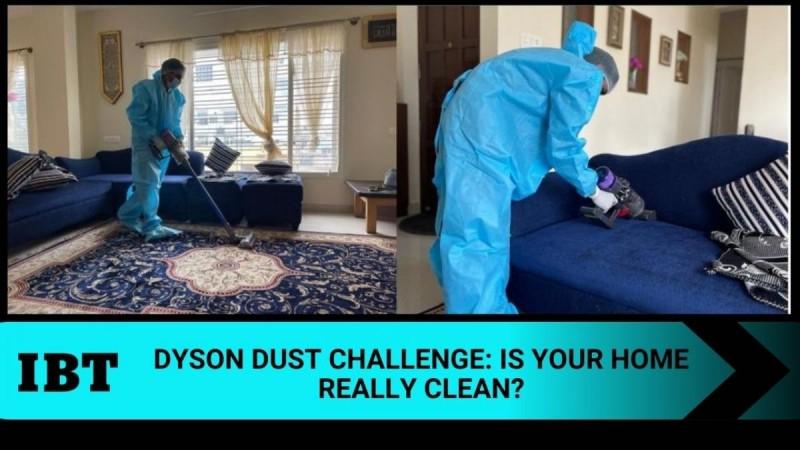Dyson is synonymous with cleanliness, be it your household or the air you breathe inside your homes. Putting that expertise to use, Dyson commissioned a study to understand how clean an average Indian household after traditional cleaning practices and the results are shocking. For this, Dyson collected dust samples from 45 houses and 277 surfaces in Delhi NCR, Bengaluru and Mumbai using the V8 Absolute+ cord-free vacuum cleaner.
For the purpose of this study, we also participated to better understand the kind of dust found in our household, which is located on the third-floor of a rarely-busy street in Bengaluru's residential area. Since we knew our cleaning habits, it was easier to gauge the importance of deep cleaning over traditional cleaning methods.
In the interest of full disclosure, our daily cleaning ritual involved dusting, sweeping and mopping - without a vacuum cleaner. Although the dust samples were collected from four areas - sofa, mattress, carpets and car interiors - the sofa and the carpets would be cleaned regularly while the interior of the car and mattress would be cleaned weekly and quarterly, respectively.

Dyson followed the same method for collecting dust from 45 households and shared the results, both independent and combined.
We were ambitious in assuming our house was clean, but the first shocker came to us when the Dyson engineer showed us the dust collected from our sofa, carpet, mattress and car. The second shocker was when the dust sample was tested and the individual results were shared with us. As per the findings, the carpet was the dirtiest, not visibly of course, but hiding deep under the furs. It didn't come as surprise as it was most stepped upon area of the house and traditional cleaning methods were no were sufficient. At least any longer.
Why are traditional cleaning methods no longer acceptable?
The saliva, faeces and shedding body parts of cockroaches can trigger both asthma and allergies. The presence of cockroach allergens was commonly detected in homes surveyed, across surfaces including mattresses. Most houses showed the presence of dog and dust mite allergens. House dust mites are major causes of allergic reactions worldwide.
![Dyson study shows we are cleaning our houses wrong; shows the way [details]](https://data1.ibtimes.co.in/en/full/758861/dyson-study-shows-we-are-cleaning-our-houses-wrong-shows-way-details.jpg?h=450&l=50&t=40)
Shockingly, the cockroach allergens were commonly found in Indian households. They are microscopic, so won't be visible to the naked eye. But the effect they have on one's health is quite real and serious. Also, dust mites allergens, which feed on human dead skin, were commonly found in the households.
Despite traditional cleaning methods, our households are not as clean as we believe.
Take a look at some eye-opening facts that will blow your mind:
- The size of dust mite allergens, mould spores and other insect allergens is often between 0.5 to 5 microns
- Dust contains a high percentage of human skin cells. An average person loses around 28g of skin per week, about the weight of a bag of crisps
- Dust mites feed off human and animal skin flakes, each mite generating around 20 droppings a day.
- 1m 2 of carpet can contain up to 1000 dust mites
- Moving around your home disturbs dust mites and their droppings, which can stay airborne for 30 minutes. In the air, they can be easily inhaled and trigger allergic reactions
- Dust mites thrive in dark and warm conditions, like mattresses which cannot be cleaned by regular techniques. Beds can contain between 100,000 and more than 1 million dust mites
- Pet allergies are common, but pet fur often isn't the problem; the proteins found in pet saliva, urine and dander (dead skin cells) disperse in the form of dust
- Wearing shoes indoors, you track animal faeces, pollen, fertilizers, motor oil, construction materials, toxic compounds and miscellaneous organisms to every room of the house
- The health risks to babies from pollutants in household dust may be 100 times greater than for adults
- There are on average more than 2000 distinct types of microbes in our dust
What should you do?
With these facts, it is clear that traditional sweeping, dusting and mopping isn't helping much. But to get rid of all the dust from your house might be unrealistic or extremely challenging. But Dyson is offering a solution that makes living in your home safe. Dyson machines can capture 99.97% particles as small as 0.3 microns. Dyson vacuum cleaner is designed to clean mattresses and sofas with a powerful suction of 185W.

Alternatively, "Source control or limiting one's exposure to allergens is paramount. Not doing so tends to make exacerbations (or attacks) frequent. The analogy that I give my patients is that of a patient with diabetes paying no attention to his/her diet and having to therefore constantly increase the dose of medications to keep the disease under control. Limiting ones exposure would include keeping ones home as clean as feasible, not ignoring mold growing on walls, wearing a mask when cleaning closets, avoiding strong smells/perfumes/room fresheners/burning incense/mosquito coils/cold dry air, choosing not to have a pet if you are atopic (are predisposed to allergies) and avoiding foods that one is allergic to," Dr. Lancelot Mark Pinto, Consultant Pulmonologist, P.D Hinduja Hospital & MRC, said.















